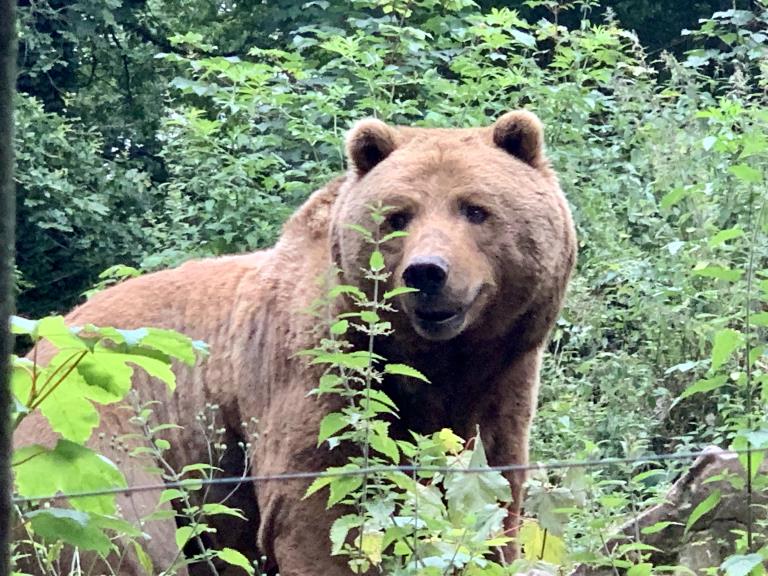Senda del Oso
The Senda del Oso is a pedestrian and cycle track that crosses the councils of Quirós, Santo Adriano, Proaza and Teverga. These four councils make up the so-called Los Valles del Oso region, as it is a refuge for one of the last populations of the Cantabrian Brown Bear, one of the three species of brown bear in Europe.
A section of La Senda del Oso
It runs on an old mining railway track, which means that the entire Senda del Oso is of low difficulty and with little unevenness. It is well signposted and has a well-conditioned pavement protected by wooden fences, as well as several rest and recreation areas with various information panels on the route.
Through the 40 kilometers of route that make up the Senda del Oso, crossing several tunnels (illuminated) and bridges, we will see practically all of the most striking elements that nature and traditional Asturian culture make available before our eyes. our scope.
One of the points of interest through which the Senda del Oso runs is the "Cercado de los Osos". It is a mountain surface of more than four hectares completely fenced with protective fences that allow its two protagonists to live at ease and in semi-freedom: the bears Paca and Tola.
Paca and Tola are two sisters who little by little have become the pampered hosts of the Valles de Oso as well as the symbol of protection of Asturian nature.

A Novel Life
Some sudden and strange noises that the echo quickly diffused among the mountains aroused the curiosity of two little female bear cubs, barely 5 months old, who were playing happily inside her burrow.
When they looked outside, they saw how the inanimate head of her protective mother seemed to be watching with a helpless gesture after having been shot dead by a poacher.
It was June 1989, and the two little bears ended a purely wild life to begin another that fate had prepared for them under the shelter of that same species that had just left them orphaned.
One night, a few days later, the two puppies were abandoned inside a ruined monastery in the council of Tineo, from where they would paradoxically be rescued by another, this time responsible, a hunter, who then alerted the Nature Protection Service. of the Civil Guard (SEPRONA).
The journey of Paca and Tola
The two bears were first transferred to a facility in the Llanes council guarded by the Fund for the Protection of Wild Animals (FAPAS).
Later they traveled to Vic, in Catalonia, and then lived for a time in the El Hosquillo National Hunting Park, in Cuenca.
Paca or Tola in the Cercado de los Osos
In 1996 they returned to their native Asturias where the entire slope of a mountain, fenced off and conditioned for them, and the protection of the Oso de Asturias Foundation (FOA) awaited them. And with the exception of five months in 2004 that they spent in shelters in the Cabárceno Park, while their fence, broken by a landslide, was rebuilt, they have lived there ever since.
The origin of the names of the bears are those of the hunter who rescued the bears (Tola) and a member of FAPAS who initially welcomed them (Paca).
Reproduction Project
In Europe there are three evolutionary lines of brown bear: the Nordic, the Eastern and the Cantabrian. Paca and Tola are the only genetically pure Cantabrian brown bears in captivity that currently exist in Spain.
That is why a reproduction plan has been developed that, based on them, creates a nucleus of brown bears that will remain in their same semi-freedom regime.
To this end, a mixed committee of veterinarians who are members of the Cabárceno Nature Park and the University of León have selected a male bear from the aforementioned Cantabrian Park to inseminate the Asturian female bears.
The chosen one is called Furaco, a bear of about 13 years and weighing 302 kilos, which for several weeks has already been in a special fence next to the bears, both built for the occasion in the Santo Adriano council, where he will try to with a progressive approach teach them the rituals of sexual courtship.
The ebardos Paca and Tola breastfed by their keepersAnd it must be remembered that Paca and Tola have not had contact with other specimens of their species, and humans have been their only companions in these 19 years of their lives. Nor have they been able to enjoy the process of breastfeeding and natural learning that their mother would have taught them, so it will be necessary to assist them in the way of raising their future cubs.
"Furacu" in Asturian means "hole". According to the explanation of the Cantabrian president, Miguel Ángel Revilla, the name was given to him by an Asturian veterinarian who treated a wound when he was a puppy and who commented "What a furacu he had!"
Demonstrating his famous humorous vein, Revilla affirmed that "Furaco is not going to fail" and that the bear's diet of "anchovies and sobaos" guarantees the success in reproduction of Paca and Tola.
The reproduction project, which has aroused great expectations not only in Asturias but throughout the Cantabrian area, has only just begun, and although everything has been prepared to obtain results in the near future, Paca and Tola still have about 6 left. years of fertility, so there is no undue rush.
We will continue to report from this page if there is any happy news. ;)


